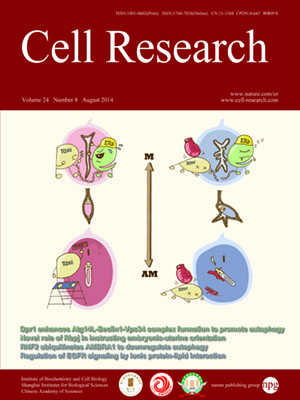
Volume 24, No 8, Aug 2014
ISSN: 1001-0602
EISSN: 1748-7838 2018
impact factor 17.848*
(Clarivate Analytics, 2019)
Volume 24 Issue 8, August 2014: 1017-1020
LETTERS TO THE EDITOR
TET-catalyzed 5-methylcytosine hydroxylation is dynamically regulated by metabolites
Hui Yang1, Huaipeng Lin1, Haiyan Xu2, Lei Zhang3, Lu Cheng4, Bo Wen4, Jianyong Shou2, Kunliang Guan1,5, Yue Xiong1,6 and Dan Ye1
1Molecular and Cell Biology Lab of Key Laboratory of Molecular Medicine of Ministry of Education and Institutes of Biomedical Sciences, Shanghai Medical College, College of Life Science, Fudan University, Shanghai 200032, China
2China Novartis Institutes for BioMedical Research, Shanghai, China
3Department of Chemistry, Institute of Stem Cell Research and Regenerative Medicine, Fudan University, Shanghai 200032, China
4Department of Biochemistry and Molecular Biology, Institute of Stem Cell Research and Regenerative Medicine, Fudan University, Shanghai 200032, China
5Department of Pharmacology and Moores Cancer Center, University of California San Diego, La Jolla, California 92093, USA
6Lineberger Comprehensive Cancer Center, Department of Biochemistry and Biophysics, University of North Carolina at Chapel Hill, North Carolina 27599, USA
Correspondence: Dan Ye,(yedan@fudan.edu.cn)
DNA methylation suppresses gene expression and plays a broad and important role in diverse biological processes such as development and tumor suppression1,2. DNA methylation is generally thought to be relatively stable and heritable. This view is recently changed by the discovery of TET (ten-eleven translocation) family of dioxygenases which catalyze three sequential oxidation reactions: converting 5mC first to 5hmC, and then 5-formylcytosine (5fC), and finally 5-carboxylcytosine (5caC)3,4,5,6,7. A subsequent decarboxylation of 5caC could then lead to DNA demethylation3. While the biological function and catalytic mechanism of TET enzymes are being extensively investigated, much less is currently known about their regulation. TET proteins are the members of Fe(II)/α-ketoglutarate (α-KG)-dependent dioxygenases, which require Fe(II) as a metal cofactor and α-KG as a co-substrate8,9. In various types of tumors, pathological accumulation of three metabolites, 2-HG, succinate and fumurate, that share structural similarity with α-KG, results in a competitive inhibition of α-KG-dependent TET activity, leading to a hypermethylation phenotype10,11. α-KG is produced and consumed mainly by four different metabolic pathways: as a key intermediate in the TCA cycle for energy metabolism, as an entry point for several 5-carbon amino acids to enter the TCA cycle (anaplerosis) after being converted into glutamate, being reduced back to isocitrate and then citrate for the eventual synthesis of acetyl-CoA, and being used as a co-substrate for multiple α-KG-dependent dioxygenases. These features of α-KG led us to investigate how a change in energy metabolism may influence TET activity in vivo.
10.1038/cr.2014.81
FULL TEXT | PDF
Browse 2086


